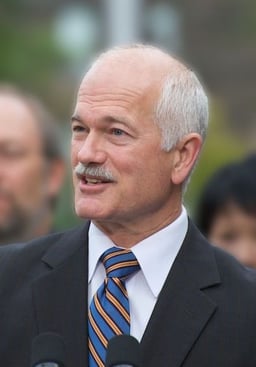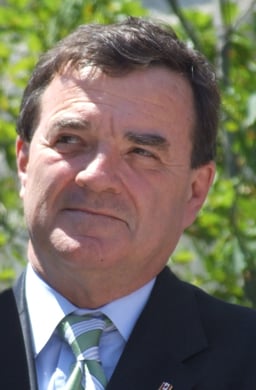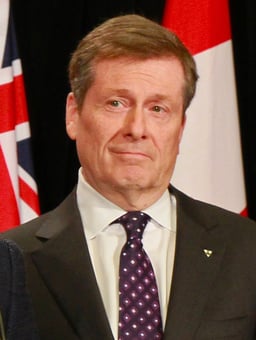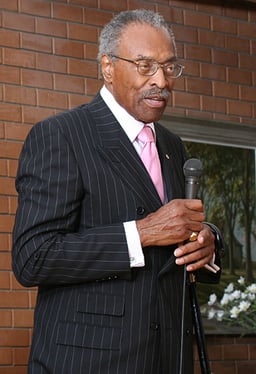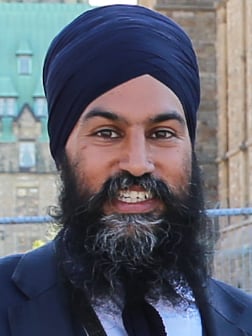York University
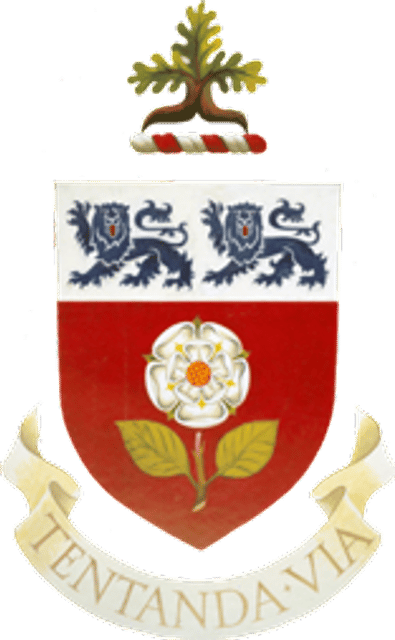
York University

| Motto | Tentanda via (Latin) | ||
|---|---|---|---|
Motto in English | The way must be tried | ||
| Type | Public university | ||
| Established | 1959 | ||
| Endowment | $467.7 million[1] | ||
| Chancellor | Gregory Sorbara | ||
| President | Rhonda Lenton[2] | ||
| Provost | Lisa Philipps | ||
Administrative staff | 7,000 | ||
| Students | 55,700 | ||
| Undergraduates | 49,700[3] | ||
| Postgraduates | 6,000 | ||
| Location | Toronto ,,Canada 43°46′23″N 79°30′13″W [104] | ||
| Campus | Urban / suburban, 185 ha (457.14 acres) | ||
| Colors | |||
| Nickname | York Lions | ||
| Affiliations | AUCC, CARL, IAU, COU, U Sports, OUA, CUSID, Fields Institute, Ontario Network of Women in engineering, CBIE, CFS, CUP. | ||
| Mascot | Yeo the Lion | ||
| Website | www.yorku.ca [105] | ||
 | |||
| University rankings | |||
| Global rankings | |||
| ARWU World[45] | 501–600 | ||
| QS World[46] | 511–520 | ||
| Times World[47] | 401–500 | ||
| U.S News & World Report Global[48] | 408 | ||
| Canadian rankings | |||
| ARWU National[45] | 19–20 | ||
| QS National[46] | 18 | ||
| Times National[47] | 16–18 | ||
| U.S News & World Report National[48] | 17 | ||
| Maclean's Comprehensive[49] | 9 | ||
York University (French: Université York) is a public research university in Toronto, Ontario, Canada. It is Canada's third-largest university,[3] and it has approximately 55,700 students, 7,000 faculty and staff, and over 300,000 alumni worldwide.[3] It has eleven faculties, including the Faculty of Liberal Arts & Professional Studies, Faculty of Science, Lassonde School of Engineering, Schulich School of Business, Osgoode Hall Law School, Glendon College, Faculty of Education, Faculty of Health, Faculty of Environmental Studies, Faculty of Graduate Studies, the School of the Arts, Media, Performance and Design (formerly the Faculty of Fine Arts), and 28 research centres.
York University was established in 1959 as a non-denominational institution by the York University Act,[4] which received Royal Assent in the Legislative Assembly of Ontario on 26 March of that year.[5] Its first class was held in September 1960 in Falconer Hall on the University of Toronto campus with a total of 76 students.[6] In the fall of 1961, York moved to its first campus, Glendon College, and began to emphasize liberal arts and part-time adult education.[5] In 1965, the university opened a second campus, the Keele Campus, in North York, within the neighbourhood community of York University Heights.
Several of York's programs have gained notable recognition both nationally and internationally. York houses Canada's oldest film school,[7] which has been ranked one of the best in Canada,[8] with an acceptance rate comparable to that of USC School of Cinematic Arts and Tisch School of the Arts.[9] York's Osgoode Hall Law School was ranked fourth best in Canada, behind U of T, McGill, and UBC.[10] In The Economist's 2011 full-time MBA rankings, York's Schulich School of Business ranked ninth in the world, and first in Canada,[11] and in CNN Expansion's ranking of MBA programs, Schulich ranked 18th in the world, placing first in Canada.[12] York's School of Kinesiology and Health Science [106] ranked 4th in Canada and 24th best in the world in 2018.[13]
| Motto | Tentanda via (Latin) | ||
|---|---|---|---|
Motto in English | The way must be tried | ||
| Type | Public university | ||
| Established | 1959 | ||
| Endowment | $467.7 million[1] | ||
| Chancellor | Gregory Sorbara | ||
| President | Rhonda Lenton[2] | ||
| Provost | Lisa Philipps | ||
Administrative staff | 7,000 | ||
| Students | 55,700 | ||
| Undergraduates | 49,700[3] | ||
| Postgraduates | 6,000 | ||
| Location | Toronto ,,Canada 43°46′23″N 79°30′13″W [104] | ||
| Campus | Urban / suburban, 185 ha (457.14 acres) | ||
| Colors | |||
| Nickname | York Lions | ||
| Affiliations | AUCC, CARL, IAU, COU, U Sports, OUA, CUSID, Fields Institute, Ontario Network of Women in engineering, CBIE, CFS, CUP. | ||
| Mascot | Yeo the Lion | ||
| Website | www.yorku.ca [105] | ||
 | |||
| University rankings | |||
| Global rankings | |||
| ARWU World[45] | 501–600 | ||
| QS World[46] | 511–520 | ||
| Times World[47] | 401–500 | ||
| U.S News & World Report Global[48] | 408 | ||
| Canadian rankings | |||
| ARWU National[45] | 19–20 | ||
| QS National[46] | 18 | ||
| Times National[47] | 16–18 | ||
| U.S News & World Report National[48] | 17 | ||
| Maclean's Comprehensive[49] | 9 | ||
History
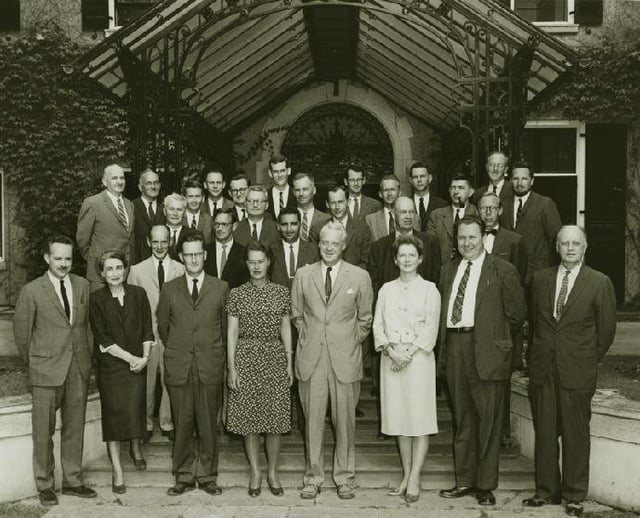
York University Faculty Members, 1961
York University was established in 1959 as a non-denominational institution by the York University Act,[4] which received Royal Assent in the Legislative Assembly of Ontario on 26 March of that year.[5] Its first class was held in September 1960 in Falconer Hall on the University of Toronto campus with a total of 76 students.[6]
The policy of university education initiated in the 1960s responded to population pressure and the belief that higher education was a key to social justice and economic productivity for individuals and for society.[5] The governance was modelled on the provincial University of Toronto Act of 1906, which established a bicameral system of university government consisting of a senate (faculty), responsible for academic policy, and a board of governors (citizens) exercising exclusive control over financial policy and having formal authority in all other matters. The president, appointed by the board, was to provide a link between the two bodies and to perform institutional leadership.[5]
In the fall of 1961, York moved to its first campus, Glendon College, and began to emphasize liberal arts and part-time adult education.[5] York became independent in 1965, after an initial period of affiliation with the University of Toronto (U of T), under the York University Act, 1965.[19] Its main campus on the northern outskirts of Toronto opened in 1965.[6]
Murray Ross, who continues to be honoured today at the University in several ways – including the Murray G. Ross Award – was still vice-president of U of T when he was approached to become York University's new president.[20] At the time, York University was envisaged as a feeder campus to U of T, until Ross's powerful vision led it to become a completely separate institution.[21]
In 1965, the university opened a second campus, the Keele Campus, in North York, in the Jane and Finch community.[22] The Glendon campus became a bilingual liberal arts college led by Escott Reid, who envisaged it as a national institution to educate Canada's future leaders, a vision shared by Prime Minister Lester Pearson, who formally opened Glendon College in 1966.[22]
The first Canadian undergraduate program in dance opened at York University in 1970.[20] In 1972, Canada Post featured the nascent institution on 8¢ stamps, entitled York University Campus, North York, Ont.[23] The first Canadian PhD. program in Women's Studies opened with five candidates in January 1992.[20]
Its bilingual mandate and focus on the liberal arts continue to shape Glendon's special status within York University.[24] The new Keele Campus was regarded as somewhat isolated, in a generally industrialized part of the city. Petrol storage facilities are still across the street. Some of the early architecture was unpopular with many, not only for the brutalist designs, but the vast expanses between buildings, which was not viewed as suitable for the climate. In the last two decades, the campus has been intensified with new buildings, including a dedicated student centre and new fine arts, computer science and business administration buildings, a small shopping mall, and a hockey arena. The Aviva Centre tennis stadium, built in 2004, is a perennial host of the Canada Masters tennis tournament. As Toronto has spread further out, York has found itself in a relatively central location within the built-up Greater Toronto Area (GTA), and in particular, near the Jane and Finch neighbourhood. Its master plan envisages a denser on-campus environment commensurate with that location. Students occupied the university's administration offices in March 1997, protesting escalating tuition hikes.[20]
In June 2014, the university announced that a new campus would be constructed in Markham, Ontario.[25] The campus will be built near Highway 407, between Kennedy Road and Warden Avenue in partnership with Seneca College.[26] The new campus would house approximately 4,200 students[27] and is anticipated to accommodate up to 10,000 students in future phases.[28] On May 20, 2015, the provincial government announced it will provide financial contribution to this new project.[29]
On October 24, 2018, the provincial government announced it would pull its funding for the campus, along with funding for the planned satellite campuses of Laurier University and Ryerson University.[30][31] After this cancellation of funding for the Markham project, York University and its partners planned to seek alternative funding.[32]
Labour disruptions
Key issues in the strike included retirement, funding, and institutional governance. In 2001, teaching assistants and contract faculty went on strike for 11 weeks, when the university broke its own record.[35] The central issue in the 2001 disruption was the administration's proposed attempts to remove tuition indexation language.
2008 CUPE 3903 Strike
A strike beginning on November 6, 2008[36] concerned a variety of institutional grievances, including job security for contract professors, elimination of the Non-Academic Student Code of Conduct, creation of whistleblower protection, and fund indexation. On January 20, 2009, CUPE 3903 defeated a forced ratification vote that would have ended the strike. On January 24, Ontario premier Dalton McGuinty announced a rare Sunday recall of the provincial legislature in order to pass back-to-work legislation mandating an immediate end to the strike.[37] On January 29, the York University Labour Disputes Resolution Act was passed in the provincial parliament on a count of 42–8 ending the long 85-day strike and setting a precedent for future university strikes in Ontario.
2015 CUPE 3903 Strike
An additional strike by teachings assistants, contract faculty, and graduate assistants took place throughout March 2015. When the strike began, on March 2, the university cancelled nearly all classes because about 2/3 of York courses were taught by the striking contract faculty at the time. On March 10, the contract faculty ratified a new agreement, but the teaching assistants and graduate assistants rejected tentative agreements the bargaining team had reached with the university. The teaching assistants and graduate assistants, continued their strike until the end of the month. Contract faculty did not go back to work in support of the union and classes remained cancelled. The union reached a tentative agreement with the university on March 29, 2015 which was ratified on March 31, 2015, thus putting an immediate end to the 29-day strike.
2018 CUPE 3903 Strike
Units 1, 2, and 3 of CUPE Local 3903, the union represented by teaching assistants, contract faculty, and graduate assistants, began striking on Monday, March 5, 2018; several months after their previous collective agreement expired on August 31, 2017. The union's aim was to, in their words, "secure a fair collective agreement that, among other things, protected quality education and creates a less precarious working environment in Ontario's university sector."[38] The main issues of the strike revolved around job security and the path to permanent tenured employment for contract faculty. A forced ratification vote was held between April 6–9 and was rejected by an overwhelming majority by all three units. [39] On June 13, a ratification vote was held for Unit 2 members, where the union executives recommended voting against the university's offer.[40] The results of the vote were thrown out due to the fact that there were more ballots cast than signatures of eligible voters.[41] A re-vote was held on June 14 and 15, where Unit 2 ratified the university's offer, with 239 members voting in favour, and 122 opposed. Units 1 and 3 remained on strike until July 25, when the newly formed 42nd Parliament of Ontario led by Premier Doug Ford passed back-to-work legislation via the Urgent Priorities Act, ending the strike after 143 days, making it the longest strike in the post-secondary sector in Canadian history.
Academics
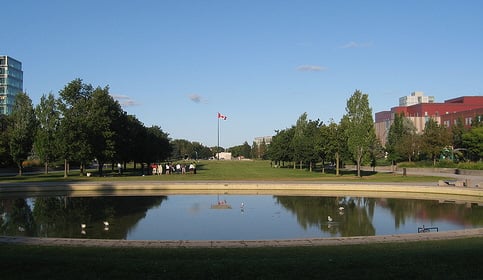
Reflecting pool in the Harry W. Arthurs Common
York has educated some of the current and past directors and CEOs of Canada's major banks (Bank of Nova Scotia, Bank of Montreal), the largest and most prominent media networks in Canada (CTV Television Network, Rogers Communications, Canadian Broadcasting Corporation), and numerous judges, diplomats, and senior politicians including a former Chief Justice of the Federal Court of Appeal of Canada, the Minister of Finance of Canada and the former Canadian Ambassador to the United Nations. Astronaut Steve MacLean was educated at York University in the physics department and later taught there before going to work at Stanford University.
Admissions
York University has over 120 undergraduate programs with 17 degree types (BA, iBA, BHS, BSc, iBSc, BBA, iBBA, BEng, BES, BDes, BPA, BFA, BCom, BEd, BDEM, BHRM, BScN, BSW) and offers over 170 degree options. They admit to 30 international degrees offering international language study and opportunities to study abroad at more than 100 international universities. In 2012, 8,238 Graduate applications were received and 53,198 Undergraduate applications [citation needed]. Its international students represent over 150 countries around the world. York University is one of the few universities to offer a GAP year for students who wish to travel abroad, study religious development or work and still keep their offer [citation needed]. York also allows students who are having immigration or financial difficulties to defer their offer for up to one year. York University's Film Department houses Canada's oldest film school.[44]
Reputation
York University has ranked in a number of post-secondary rankings. In the 2019 Academic Ranking of World Universities rankings, the university ranked 501–600 in the world and 19–20 in Canada.[45] The 2020 QS World University Rankings ranked the university 511–520 in the world, and eighteenth in Canada.[46] The 2020 Times Higher Education World University Rankings ranked York 401–500 in the world, 16–18 in Canada. York ranked 14th Globally & 4th in Canada in the Times Higher Education Impact Rankings for Climate Action [107] . .[47] In the 2019 U.S. News & World Report Best Global University Ranking, the university ranked 408th in the world, and 17th in Canada.[48] The Canadian-based Maclean's magazine ranked York University ninth in their 2019 Canadian comprehensive university category.[49]
The university's research performance has been noted in several bibliometric university rankings, which uses citation analysis to evaluates the impact a university has on academic publications. The 2019 Performance Ranking of Scientific Papers for World Universities ranked the university 488th in the world, and 19th in Canada,[50] whereas the University Ranking by Academic Performance placed the university 488th in the world, and 19th in Canada.[51]
York University has also been featured in rankings that evaluates the employment prospects of its' graduates. In QS's 2019 graduate employability ranking, the university ranked 301-500 in the world, and 10–17 in Canada.[52]
Faculties
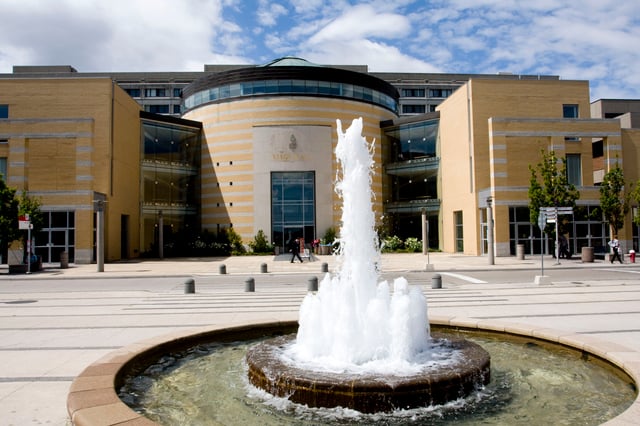
View of Vari Hall from Harry W. Arthurs Common
York University's Film Department houses Canada's oldest film school[7] and has been ranked one of the best in Canada,[8] with an acceptance rate comparable to that of USC School of Cinematic Arts and Tisch School of the Arts.[9]
York University is home to the oldest and largest environmental studies faculty in Canada.[53] From 1999 to 2018, York University offered the first and largest graphic design program in Ontario York/Sheridan Design (YSDN).[54] It was a four-year University degree delivered jointly by the two leading educational institutions of design in Canada (York University and Sheridan College). The joint program has been discontinued and beginning with the class entering in 2019, four-year design students will enroll in a new Bachelor of Design offered by York University, one which is geared for the future of the profession.[55]
The Osgoode Hall Law School moved from a downtown location to the York campus in 1969, following the requirement that every law school affiliate with a university. The law school has offered several flexible degrees available, including the Osgoode-NYU JD/LLB degree in conjunction with New York University School of Law. Osgoode Hall Law School of York University has been ranked the top law school in Canada in Canadian Lawyer magazine's 2008 Law School Survey.
York University's Faculty of Graduate Studies offers graduate degrees in a variety of disciplines, and there are several joint graduate programmes with the University of Toronto and Ryerson University. It is the second largest graduate school in the Province of Ontario.
Research centres and institutes
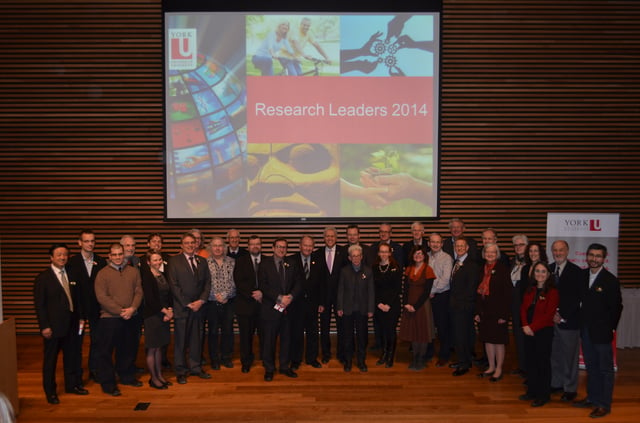
York researchers at the York University Research Leaders 2014 event.

York University was involved with NASA's Upper Atmosphere Research Satellite
Centre for Atmospheric Chemistry
Centre for Research on Biomolecular Interactions
Centre for Research in Earth and Space Science
Centre for Research in Mass Spectrometry
Centre for Vision Research (CVR)
York Institute for Social Research
York Institute for Health Research
Robarts Centre for Canadian Studies
Canadian Centre for German and European Studies
Centre for Feminist Research
Israel and Golda Koschitzky Centre for Jewish Studies
York Centre for Asian Research[56]
York Centre for International and Security Studies
York Entrepreneurship Development Institute (YEDI)
Centre for Public Policy and Law
Centre for Refugee Studies
Centre for Research on Latin America and the Caribbean
Institute for Research and Innovation in Sustainability
Institute for Research on Learning Technologies[57]
The Jack and Mae Nathanson Centre on Transnational Human Rights, Crime and Security
LaMarsh Centre for Child and Youth Research
The City Institute at York University (CITY)
Global Labour Research Centre
The Harriet Tubman Institute for Research on the Global Migrations of African Peoples
York Centre for Education and Community
Institute for Science and Technology Studies
Muscle Health Research Centre
Sensorium: The Centre for Digital Arts and Technology
Centre for Research on Language Contact
York Centre for Field Robotics
The Mariano A. Elia Chair in Italian Canadian Studies
Psychology Resource Centre
The School of the Arts, Media, Performance and Design (AMPD, formerly the Faculty of Fine Arts),[60] offers programmes such as design, ethnomusicology, cultural studies, visual arts, music, dance, and theatre. York's Jazz Department was once overseen by Oscar Peterson. York also has a joint Bachelor of Design program with Sheridan College. York's Departments of Film, Theatre and Creative Writing (which is not affiliated with the Faculty of Fine Arts) offers programmes in film production/directing, acting, and writing respectively, producing many award-winning graduates. The founders of Toronto's Hot Docs International Documentary Film Festival and CineACTION film theory magazine were graduates of York's Faculty of Fine Arts.
York's Dance department was founded by National Ballet of Canada's first choreographer Grant Strate.
York offers a Space and Communication Sciences undergraduate degree. York's Centre for Vision Research has developed a 'virtual reality room' called IVY (Immersive Virtual Environment at York) in order to study spatial orientation and perception of gravity and motion. The Canadian Space Agency and National Space Biomedical Research Institute (NSBRI) use this room to strengthen astronauts' sense of 'up' and 'down' in zero-gravity environments. The room is a six-sided immersive environment made of the glass used in the CN Tower's observation deck and includes walls, ceiling, and a floor made of computer-generated pixel maps. York's Faculty of Science and Engineering most recently took part in the 2007 NASA Phoenix Mars Mission.
York is also the only university in Canada with specialized programs in meteorological sciences at both the undergraduate and graduate level.
Faculties
Faculty of Liberal Arts & Professional Studies (LA&PS)
Faculty of Education (ED)
Faculty of Environmental Studies (ES)[61]
School of the Arts, Media, Performance and Design (AMPD, formerly the Faculty of Fine Arts)[60]
Glendon College (GL)
Faculty of Graduate Studies (GS)
Faculty of Health (HH)[62]
Osgoode Hall Law School (OS)
Schulich School of Business (SB)
Faculty of Science (SC)[63]
Lassonde School of Engineering (LE)
Seneca@York
The Keele campus is host to a satellite facility of Seneca College,[64] and York University offers a number of joint programs with Seneca College:
School of Communication Arts
Computer Studies
Biological Science and Applied Chemistry
Corporate and Technical Communications
Nursing
Libraries
There are five libraries at York University. Four of these libraries constitute the York University Libraries system: the Scott Library, Steacie Science and Engineering Library, Peter F. Bronfman Business Library, and the Leslie Frost Library (on Glendon Campus). The fifth library, the Osgoode Hall Law Library, reports to the Dean of the Osgoode Hall Law School and is the largest law library in the Commonwealth. The Scott Library also contains within it the Clara Thomas Archives and Special Collections, the Map Library and the Sound and Moving Images Library. Although the Archives of Ontario moved to York's Keele campus in April 2009, it is not affiliated with York University Libraries.
Campuses
Keele Campus
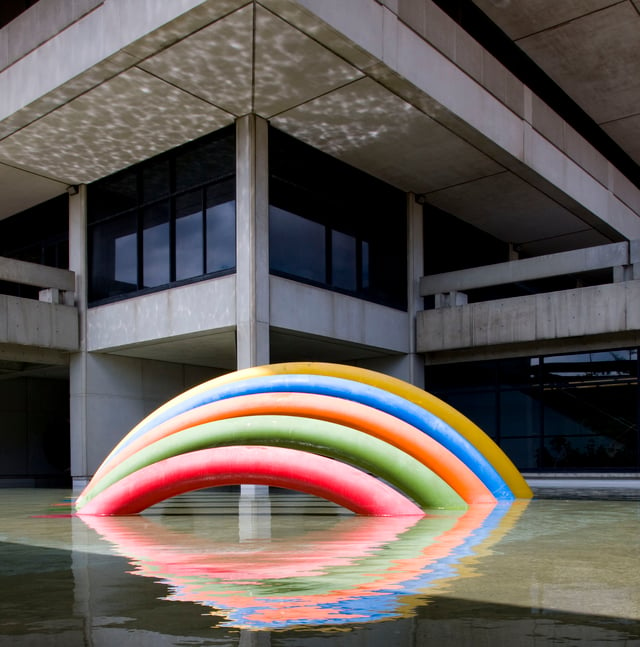
An outdoor art exhibit outside of Scott Library, Keele Campus
York's primary campus ("The Keele Campus") is in the north of the City of Toronto and bordering York Region. It is the largest post-secondary campus in Canada at 457 acres.[65] Most of the University's faculties reside here, including Liberal Arts, Fine Arts, Business, Law, Environmental Studies, Science and Engineering, Education, and Health. All together, nearly 50,000 students attend classes on the Keele campus.
Glendon Campus
Glendon College is a bilingual liberal arts faculty and separate campus of York University in the Toronto neighbourhood of Lawrence Park. Glendon is unique amongst York faculties as it possesses autonomy over both its recruitment and admission. The College hosts its own academic programs and facilities. Student services on Campus are provided in both French and English and all Glendon students are required to take courses in both French and English to graduate. Glendon is the only university-level institution in central Southern Ontario that offers university courses in both French and English. Further, it is the only University Campus in Ontario that requires students to take courses in both official languages of Canada. The Campus is made accessible through TTC Routes 124-Sunnybrook and 11-Bayview and a frequent shuttle bus that runs between Glendon and York's Keele Campus. Glendon students are free to take courses and access Libraries and institutional services offered at the Keele campus (and vice versa).
Satellite campuses
While most of the Schulich School of Business and Osgoode Hall Law School programs are offered at the Keele Campus, both of them maintain satellite facilities in downtown Toronto. Schulich operates the Miles S. Nadal Management Centre at 222 Bay Street (Ernst & Young Tower within the Toronto-Dominion Centre), while Osgoode Hall has a Professional Development Centre at One Dundas West Tower within the Toronto Eaton Centre.
Faculty of Environmental Studies The Lillian Meighen Wright Centre is billed as an eco campus next to Las Nubes Forest Reserve in Costa Rica.[66]
Student life
Colleges and residences
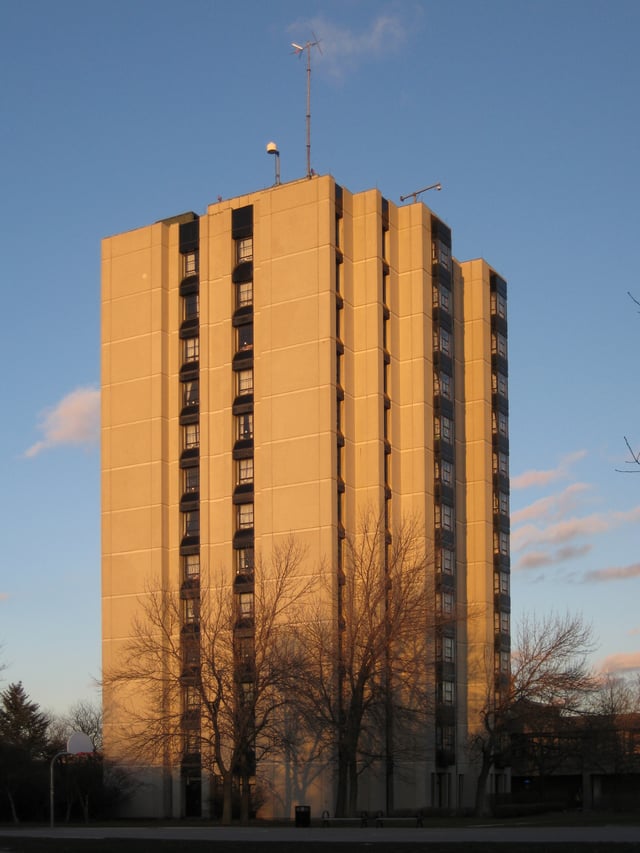
Vanier Residence
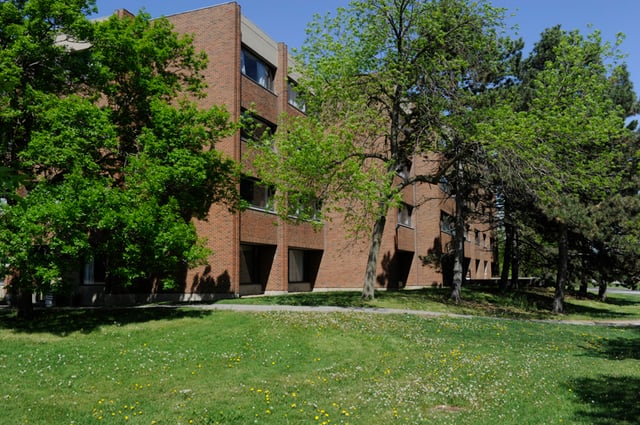
Winters Residence
York has nine undergraduate residential colleges:
| Name (Founded) | Motto/Mandate | Academic Affiliations | Namesake | |
|---|---|---|---|---|
| Calumet(1970) | "Technology and the Arts" | Business Administration, Economics, Business and Society, Cognitive Science, Communication Studies, Psychology | Norman-French for pipe or pipestem. | |
| Founders(1965) | "Self, Culture & Society" | Anthropology, English, Environmental Studies, French, Geography, Italian, History, African studies, East Asian studies, Social Work, Latin American and Caribbean Studies, South Asian Studies, International Development, Urban studies | The Group of Seven, often referred to as "The Founders of Canadian Art" | |
| Glendon(1966) | Bilingual Liberal Arts | Liberal Arts, English, French, Public Policy, International Affairs | A combination of "glen" meaning "valley" and "Don" for the Don River. | |
| McLaughlin(1968) | Public Policy & Social Sciences | Political Science, Sociology, Law and Society, Criminology, Public Policy, Health and Society, Labour Studies | Colonel Samuel McLaughlin, businessman and philanthropist. | |
| New College(2009) | Professional Studies | Human Resources, Commerce, Information Technology | Newest college at York University. | |
| Norman Bethune(1972) | "Science and its Place in the World" | Natural Sciences, Engineering, Science and Technology Studies (formerly Science and Society) | Norman Bethune, Canadian doctor and Chinese hero. | |
| Stong(1969) | Language and Sport | Kinesiology, Health Science | The Stong family lived on the land now occupied by the Keele campus. | |
| Vanier(1965) | Humanities | Children's Studies, Classical Studies & Classics, Culture and Expression, Hellenic Studies, Individualized Studies, Jewish Studies, Liberal Studies, Philosophy, Religious Studies, Social and Political Thought, all Undecided Majors in the Faculty of Liberal Arts and Professional Studies | Georges Vanier, Governor-General of Canada. | |
| Winters(1967) | Fine Arts & Education Studies | Arts, Media, Performance & Design, Faculty of Education | Robert Winters, Canadian Cabinet Minister and York's first chairman. | |
| Glendon College acts as both a faculty and a college of the university. New College was created in 2009 to accommodate the creation of the Faculty of Liberal Arts and Professional Studies. | ||||
Residence Life at York University is part of the Centre for Student Community and Leadership Development (SCLD), that manages the eight residence buildings on the Keele campus. These Residences are divided into two complexes on either side of campus: Complex 1 includes Winters Residence, Tatham Hall Residence, Vanier Residence, and Founders Residence; Complex 2 includes Bethune Residence, Calumet Residence, Stong Residence, and Pond Residence (the newest residence, and sometimes referred to as Complex 3 grouped with the York Apartments). Each residence is linked to one of the aforementioned colleges, but since 2007 have been managed through SCLD rather than the Master's Offices of each College. Residence Life works closely in partnership with Student Housing Services, a separate campus office. Residence Life provides and manages the student programming and support, while Housing Services manages the facilities, room placements and application processes. The Residence Life Staff is composed of Residence Life Coordinators, Residence Dons, and Night Porters designated to each building. Residence Life also maintains important partnerships with several campus services, including but not limited to Security Services, Food Services, Sport and Recreation, Centre for Human Rights, Office of Student Conflict Resolution, York Federation of Students, and Colleges and College Councils.
The Village at York University
The Village at York University[67] off-campus student housing area has become a popular area of accommodation for many upper-year and post-graduate students, and the area has had a large amount of attention particularly for large parties hosted by students, including the annual Battle of the Village kegger held in March. There have also been many reports of the level of noise pollution from late-night parties from students living in the area.[68] Safety has also been a pressing issue.
The Village is a residential neighbourhood within the City of Toronto, occupying about 130 acres beyond the south boundary of York University's property. Residential dwellings in The Village are privately owned, and homeowners in this community are City of Toronto taxpayers. York University participates in the Village At York Town and Gown Committee, with representatives of residents of The Village; the York Federation of Students; Toronto Police Service and Toronto Fire Service, as well as other key municipal agencies and the local Councillors' office. This committee addresses concerns of residents, students, the City and the University, such as community safety and by-law enforcement and compliance.
Campus media
Excalibur has been the university's autonomous student newspaper since 1966. In 2008, the YU Free Press was formed as an alternative campus newspaper.[69]
Colleges and some programs also have individual newspapers or magazines. They include: The Flying Walrus (Stong College), MacMedia (McLaughlin College), The Pipe (Calumet College), Artichoke (Winters College), SOFA (Spotlight On Fine Arts), The Lexicon (Norman Bethune College), The Vandoo (Vanier College), The Phoenix (Founders College), Pro Tem (Glendon College), Obiter Dicta (Osgoode Law School), and The Insider (Schulich School of Business).
CHRY-FM - CHRY-FM (officially known as Vibe 1055 FM) (est. 1986) is a radio station hosted at York University.
Existere – Journal of Arts and Literature (est. 1978) is a national publication with local and international contributors. It is financed by Vanier College Council. The journal publishes short fiction, poetry, non-fiction and art from novices and seasoned veterans. Several major writers got their early start in Existere.
YorkU Magazine (est. 2003) is the official magazine of York University. It is published 3 times a year in both a print and digital format.
Sport
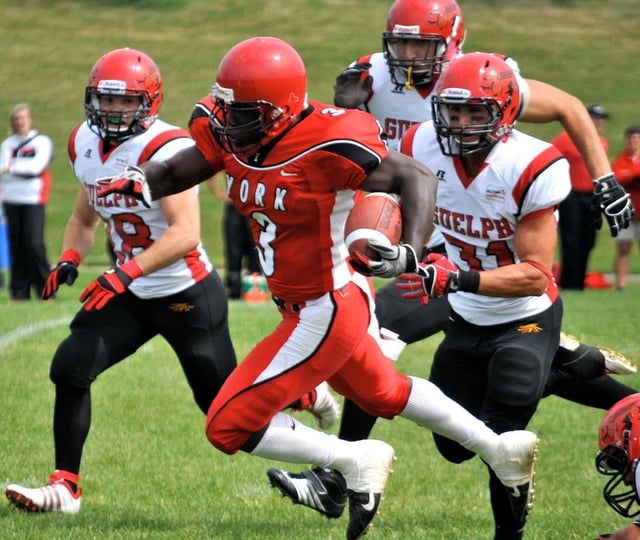
York University vs University of Guelph
The University is represented in U Sports by the York Lions. Beginning in 1968 York's sporting teams were known as the "Yeomen", after the Yeomen Warders, the guardians of the fortress and palace at the Tower of London, otherwise known as Beefeaters. Later, the name "Yeowomen" was introduced to encourage women to participate in sports. Popular sentiment ran against this name scheme, however, as many students were fond of noting that a "Yeowoman" was fictitious, neither a real word nor having any historical merit. In 2003, after conducting an extensive internal study, the University replaced both names with the "Lions", as part of a larger renaming effort, and a new logo, now a white and red lion, was brought into line with the university's new visual scheme. The name change also brought York University in line with the 92% of other Canadian universities which use a single name for both sexes' sports teams. Ironically, students often refer to the female Lions teams as the "York Lionesses", even though the name "Lion" is intended to apply to both sexes.[70]
York offers 29 interuniversity sport teams, 12 sport clubs, 35 intramural sport leagues, special events and 10 pick-up sport activities offered daily.
York University has several athletic facilities, some of which are used for major tournaments. These include a football stadium, 4 gymnasia, 5 sport playing fields, 4 softball fields, 9 outdoor tennis courts, 5 squash courts, 3 dance/aerobic studios, 6 ice arenas, a swimming pool, an expanding fitness centre and the new Aviva Centre (home of the Rogers Tennis Cup).
In 2014 the York Lions won four banners: the Canadian Interuniversity Sport (CIS) men's national track and field championship, the Ontario University Athletics women's provincial tennis championship and both the OUA and CIS men's soccer titles. York will be hosting the 2015 CIS Men's Soccer Championships at York Stadium November, 2015.[71] In 2015 and 2016 York Lions Women's Tennis team won the Canadian University National Championships.[72]
Fight song
Notable among a number of songs commonly played and sung at various events such as commencement and convocation, and athletic games are: "York Song", sung to the tune "Harvard".[73]
There are also college songs, particularly from the friendly feuds between Stong College and Bethune College, and the infamous Winters College and Vanier College cheer songs.
Fraternities and sororities
Fraternities and sororities are not recognized by York University.[74]
Phi Delta Phi (ΦΔΦ) international legal fraternity, at Osgoode Law School, was given special dispensation when the law school became part of the university, as the fraternity's history with the law school dated back to 1896, and is recognized at York. In 2012 Phi Delta Phi internationally converted from a fraternity to an honour society.
Student clubs and other student organizations
York University is home to over 350 student clubs.[75]
A number of larger student organizations are supported by student levy fees. These include the local chapters of the social justice group OPIRG, and Regenesis, an environmental organization on campus that runs farmers' markets at the Keele and Glendon campuses, a free store, a community bike centre and an borrowing centre.
Campus safety
Many students at York University feel that York University does not do enough to notify students of security incidents on or near campus.[76]
Incidents
In June 2008, the university announced it had commissioned an external safety audit after a string of rapes on the university campus. During frosh week 2007, two men entered a campus dormitory and raped two students.[77][78] The victims were 17 and 18 years old at the time.[79] A lawsuit filed claims that "the entrance door to the college and to the residential room areas of the college were virtually wide open to the public at large".[80] The perpetrators were Daniel Katsnelson (aka Daniel Kaye or Daniel Katz) and Justin Connort.[81] The next year, in January 2008, another student was sexually assaulted in the stairwell of a campus building.[82] In May 2009, a contract security guard was shot at a York University campus pub, The Underground.[83]
In April 2010, a 20-year-old student was sexually assaulted while walking to her apartment, minutes away from the main campus.[84] The incident, described by police as "particularly severe" and resulting in "very serious" injuries for the victim, was particularly notable as it occurred just a week after Daniel Katsnelson was sentenced for the 2007 rape on the university campus.[85][86]
In April 2011, campus security was temporarily increased following the murder of a 23-year-old Chinese overseas student[87][88] in the off-campus housing neighborhood The Village at York University .[89][90][91] On August 26, 2011, York University announced that in response to recommendations in the METRAC Safety Audit, the University will be modifying the service delivery model for York Security Services (YSS) personnel. Members will be trained and issued with handcuffs and batons. Cruisers are to also be equipped with "silent partners" for transporting arrested persons.[92]
On March 6, 2014, local police employees and ambulance workers responded late at night to a shooting at the York University Student Centre. Two women were found at the scene; one had been shot and suffered non-life-threatening injuries and another received minor (non-gun-related) injuries from the suspect. A suspect was apprehended and subsequently charged.[93] On April 10, 2014, two injured students and six others who witnessed the shooting filed a $20.5 million lawsuit against the University, alleging a pattern of negligence.[94]
Presidents
Murray G. Ross, academic 1959–1970
David Slater, economist and civil servant 1970–1973
H. Ian Macdonald, economist and civil servant 1973–1984
Harry W. Arthurs, lawyer and academic 1985–1992
Susan Mann, historian and academic, 1993–1997
Lorna Marsden, academic and politician 1997–2007
Mamdouh Shoukri, academic, 2007–2017[95]
Rhonda Lenton, academic (sociologist), 2017–present[96]
Chancellors
Wilfred A. Curtis, RCAF air marshal, 1959–1968
Floyd S. Chalmers, publisher (Maclean-Hunter), 1968–1973
Walter L. Gordon, federal cabinet minister (Minister of Finance), 1973–1977
John P. Robarts, Premier of Ontario, 1977–1982
John S. Proctor, banker (President of Imperial Bank of Canada), 1982–1983
J. Tuzo Wilson, geophysicist, 1983–1986
Larry Clarke, founder of SPAR Aerospace, 1986–1991
Oscar Peterson, jazz piano great, 1991–1994
Arden Haynes, businessman (CEO and Chair of Imperial Oil), 1994–1998
Avie J. Bennett, businessman (McClelland & Stewart), 1998–2004
Peter deCarteret Cory, jurist and former Supreme Court of Canada justice, 2004–2008
Roy McMurtry, politician (Attorney General of Ontario) and judge (Chief Justice of Ontario), 2008–2014
Greg Sorbara, politician (Ontario Minister of Finance), 2014–present
Noted alumni and faculty
York has over 200,000 living alumni. Although a large number of alumni live in Ontario, a significant number live in British Columbia, Nova Scotia, Alberta, New York, and Washington, D.C. York also has over 25,000 alumni overseas.
Distinguished Research Professors and University Professors
The rank of "Distinguished Research Professor" and "University Professor" are the highest rank a professor can achieve at York University. There are only ever up to a maximum of 25 each of active Distinguished Research Professors and active University Professors at any time.[97] It is awarded to members of the faculty who have made outstanding contributions to the University through their work in research.[98]
Pat Armstrong, 2010: Sociology, Liberal Arts & Professional Studies
Gerald O. Aspinall, 1988: Chemistry, Science
Isabella C. Bakker, 2014: Political Science, Liberal Arts & Professional Studies
Norbert Bartel, 2006: Physics & Astronomy, Science
Dawn Bazely, 2017: Biology, Science[99]
Russell Belk, 2014: Schulich School of Business
Ellen Bialystok, 2003: Psychology, Liberal Arts & Professional Studies
Diethard Bohme, 1995: Chemistry, Science
John Bosher, 1989: History, Liberal Arts & Professional Studies
Deborah Britzman, 2006: Education
James Carley, 2000: English, Liberal Arts & Professional Studies
Jean-Gabriel Castel, 1986: Osgoode Hall Law School
Jerome Ch'en, 1984: History, Liberal Arts & Professional Studies
Lorraine Code, 1998: Philosophy, Liberal Arts & Professional Studies
J. Douglas Crawford, 2013: Psychology, Health
Kenneth Davey, 1984: Biology, Science
Sheila Embleton, 2009: Languages, Literatures & Linguistics, Liberal Arts & Professional Studies
Norman Endler, 1996: Psychology, Liberal Arts & Professional Studies
Stephen Gill, 2006: Political Science, Liberal Arts & Professional Studies
Jack Granatstein, 1994: History, Liberal Arts & Professional Studies
Leslie S. Greenberg, 2010: Psychology, Health
Philip Gulliver, 1985: Anthropology, Liberal Arts & Professional Studies
Henry S. Harris, 1984: Philosophy, Glendon
Robert Haynes, 1986: Biology, Science
Michael Herren, 1999: Humanities, Liberal Arts & Professional Studies
Eric Hessels, 2006: Physics & Astronomy, Science
Richard Hornsey [108] , 2015: Electrical Engineering, Lassonde School of Engineering[100]
Ian Howard, 1988: Psychology, Liberal Arts & Professional Studies
Allan Hutchinson, 2006: Osgoode Hall Law School
Christopher Innes, 1997: English, Liberal Arts & Professional Studies
Ian Jarvie, 1993: Philosophy, Liberal Arts & Professional Studies
Michael Kater, 1992: History, Liberal Arts & Professional Studies
Gabriel Kolko, 1986: History, Liberal Arts & Professional Studies
A. B. P. Lever, 1998: Chemistry, Science
Clifford Leznoff, 2003: Chemistry, Science
Paul Lovejoy, 1997: History, Liberal Arts & Professional Studies
John C. McConnell, 2005: Earth & Space Science & Engineering, Science & Engineering
Kent McNeil, 2008: Osgoode Hall Law School
Peter Moens, 1991: Biology, Science
Gareth Morgan, 1992: Commerce, Liberal Arts & Professional Studies
H. Vivian Nelles, 2001: History, Liberal Arts & Professional Studies
Ralph W. Nicholls, 1983: Physics, Science
John O'Neill, 1983: Sociology, Liberal Arts & Professional Studies
Hiroshi Ono, 2001: Psychology, Liberal Arts & Professional Studies
Leo Panitch, 1999: Political Science, Liberal Arts & Professional Studies
Debra Pepler, 2008: Psychology, Health
Huw Pritchard, 1983: Chemistry, Science
David M. Regan, 1992: Psychology, Liberal Arts & Professional Studies
Marcia H. Rioux, 2013: Health Policy & Management, Health
Nicholas Rogers, 2011: History, Liberal Arts & Professional Studies
Beryl Rowland, 1983: English, Liberal Arts & Professional Studies
Stuart Shanker, 2005: Psychology, Liberal Arts & Professional Studies
Gordon Shepherd, 1993: Earth & Space Science, Science
K.W. Michael Siu, 2008: Chemistry, Science
Brian Slattery, 2008: Osgoode Hall Law School
Donald Smiley, 1984: Political Science, Liberal Arts & Professional Studies
Martin Steinbach, 2000: Psychology, Liberal Arts & Professional Studies
Bridget Stutchbury, 2009: Biology, Science
James Tenney, 1995: Music, Fine Arts
John Tsotsos, 2008: Computer Science & Engineering, Science & Engineering
Reginald Whitaker, 2001: Political Science, Liberal Arts & Professional Studies
Jianhong Wu, 2011: Mathematics & Statistics, Science
Manyjot Sandhar, 2015: Biomedical Sciences
See also
York University station
York University Observatory
Canadian university scientific research organizations
Higher education in Ontario
Ontario Student Assistance Program
List of Ontario Universities

